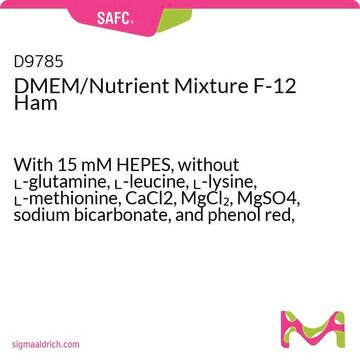D5648
DMEM - high glucose
With ʟ-glutamine, without sodium bicarbonate and sodium pyruvate, powder, suitable for cell culture
Synonim(y):
DME, Dulbecco′s Modified Eagle′s Medium - high glucose, DMEM
About This Item
Polecane produkty
product name
Dulbecco′s Modified Eagle′s Medium - high glucose, With 4500 mg/L glucose and L-glutamine, without sodium bicarbonate, powder, suitable for cell culture
Postać
powder
metody
cell culture | mammalian: suitable
komponenty
phenol red: yes
L-glutamine: yes
NaHCO3: no
HEPES: no
glucose: high
sodium pyruvate: no
Warunki transportu
ambient
temp. przechowywania
2-8°C
Szukasz podobnych produktów? Odwiedź Przewodnik dotyczący porównywania produktów
Zastosowanie
Ilość
Rekonstytucja
najczęściej kupowane z tym produktem
Kod klasy składowania
11 - Combustible Solids
Klasa zagrożenia wodnego (WGK)
WGK 1
Temperatura zapłonu (°F)
Not applicable
Temperatura zapłonu (°C)
Not applicable
Certyfikaty analizy (CoA)
Poszukaj Certyfikaty analizy (CoA), wpisując numer partii/serii produktów. Numery serii i partii można znaleźć na etykiecie produktu po słowach „seria” lub „partia”.
Masz już ten produkt?
Dokumenty związane z niedawno zakupionymi produktami zostały zamieszczone w Bibliotece dokumentów.
Klienci oglądali również te produkty
Produkty
Cell culture protocol for passaging and splitting suspension cell lines
Protokół hodowli komórkowej do pasażowania i dzielenia zawiesinowych linii komórkowych
Nasz zespół naukowców ma doświadczenie we wszystkich obszarach badań, w tym w naukach przyrodniczych, materiałoznawstwie, syntezie chemicznej, chromatografii, analityce i wielu innych dziedzinach.
Skontaktuj się z zespołem ds. pomocy technicznej




